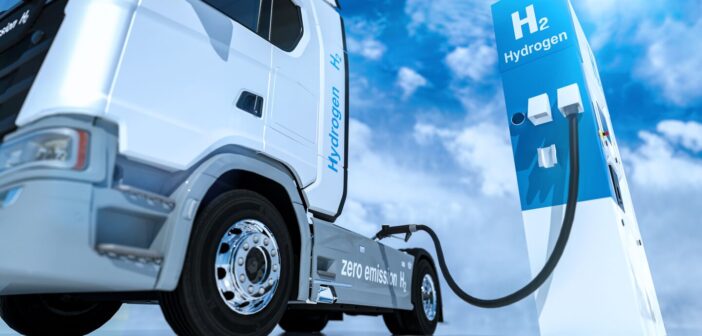The story of hydrogen spans life and the universe. Discovered by mankind just over 250 years ago, its abundance and versatility place it at the very nexus of scientific discovery and human potential.
Hydrogen is a sustainable, accessible fuel source that has the potential to reshape our energy economy, transforming industries and giving us the platform to create a sustainable future.
Hydrogen power will touch every single niche within the manufacturing landscape impacting what we make, the way we make it, and ultimately how we power not just industry, but society.
R-evolution was established by Hexagon to drive sustainable innovation through technology. We are currently working to establish a blueprint for green hydrogen production, investing a lot of research and resources into understanding the potential of hydrogen as a global, renewable fuel source.
Come with us as we take a look at hydrogen’s quirky past and developmental present to shed light on the future commercial and environmental potential of this sustainable superfuel.
Hydrogen – the past
Hydrogen has literally been around forever and, of course, had a leading role to play in the big bang. That’s quite a resume already, but hydrogen’s story goes into hyperdrive when it enters the era of human conscience.
Discovered in 1765 by Henry Cavendish, who called it “flammable air”, it took mankind a mere 42 years to develop the first hydrogen-powered motor vehicle concept. And it does not stop there; Hydrogen’s past points us to its exciting future! Here are some key innovation milestones:
- 1806 – Francois Isaac de Rivaz designed the first concept hydrogen motor vehicle. His idea harnessed hydrogen gas power.
- 1842 – Sir William Grove became the “Father of the Fuel Cell” with his creation of a gas battery that combined hydrogen and oxygen in the presence of an electrolyte.
- 1900 – the first hydrogen-filled Zeppelin LZ1 airship is launched. The Hindenburg disaster of 1937 abruptly ended the era of airship travel.
- 1941 – saw hydrogen’s first mass application in automotive. The Russian Army in besieged Leningrad converted hundreds of cars to hydrogen internal combustion to help serve air defense posts.
- 1962 – the RL-10 becomes the first hydrogen-powered rocket engine to launch off.
- 1966 – Chevrolet Electrovan became the first ever hydrogen road vehicle.
- July 20, 1969 – astronauts aboard Apollo 11 set foot on the moon. Liquid hydrogen was used not just for rocket propulsion, fuel cells gave the craft its electricity and water supply.
- 1988 – the hybrid Soviet-era Tupolev Tu-155 became the first plane to fly with liquid hydrogen power. One of its three engines ran on the fuel.
- 2010 – The world’s first hydrogen power station went live in Fusina, Italy.
Hydrogen fuel – the present
Hydrogen has a fascinating past and a future that knows no bounds, but the present is equally exciting. While it hasn’t yet become a mass market power source for vehicles or domestic energy – development is taking place at pace.
Already hydrogen has a foothold in every area of mechanised propulsion. Fuel cells are used in transport, stationary power generation and portable power. With much remaining at the concept stage, the technology is still in its commercial infancy.

Erik Josefsson visiting a hydrogen gas station. In the shot is a hydrogen-driven crawler excavator from Liebherr.
The exciting thing about where we are today is the development. Science is in action, innovation is taking place and the potential being opened up. So, what is the situation on the ground right now?
- Very few passenger cars today run on hydrogen. Fuel cell electric vehicles (FCEVs) comprise less than 0.1% of overall auto sales, which equates to just 20,000 units Currently there are just two models available, the Toyota Mirai and Hyundai Nexo. The need for infrastructure investment, lacking support from national governments as well as storage and safety concerns have limited investment with Japanese manufacturers placing the biggest bet on the technology. Many large heavy machinery producers are moving into hydrogen; Liebherr is one of the first to release hydrogen-driven crawler excavator.
- There is currently no commercial use of hydrogen in air travel, but this is something that has the entire focus of the industry. In September 2020, Airbus released three hydrogen-jet concepts including designs for craft of a similar size to the A380. In November 2022, Rolls Royce successfully completed the world’s first test run of a Hydrogen-fuelled jet engine. In March 2023, Universal Hydrogen ran a successful test of a converted ATR 72-600 turboprop. The plane nicknamed “Lightning McClean,” completed a 15-minute test flight with a pilot and two crew. With market leaders and entrants working on a raft of potentially groundbreaking projects, this will be an exciting space to watch.
- Low-emission hydrogen production remained below 1% of global hydrogen production in 2022 but it is on the rise. In the last year or so, China unveiled a record-breaking production facility powered by a 200MW solar array. Globally, some of the biggest ever projects have been announced so production will steadily rise.
- The world’s first shipment of liquefied hydrogen was sent from Australia to Japan in the world’s first purpose-built liquefied hydrogen carrier in February 2022. This was the first step in the development of a global hydrogen market.
Hydrogen economy – the future
With a view of the past and present, let’s take a look at how today’s development will unlock the hydrogen economy of tomorrow:
- The future of hydrogen for power generation – the energy sector will be one of the first mass-market adopters of hydrogen power. With projects planned, underway or due to come online globally, hydrogen will become a vital power source for domestic grids. As an example, the UK has set an ambitious commitment for up to 10GW of low-carbon hydrogen production capacity by 2030.
- The future of green hydrogen production – scaling green hydrogen production is vital. Hydrogen isn’t green unless the energy used to produce the fuel is clean. Green hydrogen has the potential to supply up to 25% of the world’s energy needs by 2050 and become a US$10 trillion addressable market by 2050, according to Goldman Sachs.
- The future of hydrogen for energy storage – with energy loss from wind and solar being a huge global issue, experts are eyeing innovative solutions, including abandoned mines, to store energy. Hydrogen may become a go-to method of storage as it allows vast quantities of clean energy to be stored for long periods. This versatility could further drive investment and uptake.
- Hydrogen’s automotive future – shopping for hydrogen cars will be a reality in the near future as the two models currently available are joined by many more that are entering production. BMW has already released a select number of iX5 hydrogen models for testing while production begins on the Honda CR-V Hydrogen in 2024. California-based supercar firm Hyperion will begin production of its XP-1 supercar in late 2023. At a market level, the global hydrogen fuel cell vehicle market is expected to grow at a CAGR of 45.5% from 2022 to 2031 taking technology from the fringes into the mainstream.
- The future of hydrogen in commercial vehicles – hydrogen’s growth in commercial vehicles is faster than expected. Falling costs, increased range and quick charge times are driving a shift that will see the fuel’s use in commercial vehicles continue to rise over the coming years.
- The future of hydrogen in aviation and aerospace – the entire focus of aviation is directed at hydrogen. Airbus plans to launch the world’s first commercial hydrogen-powered aircraft by 2035. As well as fast-tracking aircraft and engine designs, and finding fuel storage solutions – there’s a lot of work to do to ready the industry for the switch, including a major overhaul of ground infrastructure. Experts predict that by 2050 aviation could be around a third hydrogen powered with the International Council on Clean Transportation (ICCT) estimating that if technology progresses as planned, liquid hydrogen could dominate the short and medium-haul aircraft market by 2050.
- The future of hydrogen distribution – liquid organic carriers are the main method of distribution currently. As the network develops, hydrogen will be distributed via specialised shipping vessels, national networks of pipelines and fuelling stations, much as petrol and diesel distribution works today.
While the future of hydrogen is exciting, it’s important to note that there are still challenges to overcome, including maturation of technology, time to market and the commitment of governments and industries to reduce greenhouse gas emissions.
However, despite these obstacles, as the world continues to focus on decarbonisation and cleaner energy sources, hydrogen’s exciting, ever-developing story will play an increasingly prominent role in the global energy transition.















